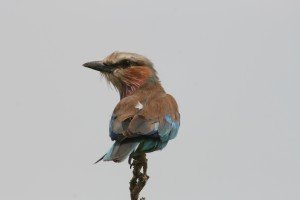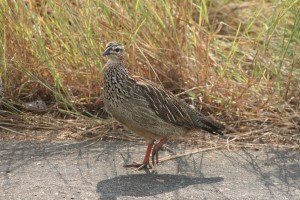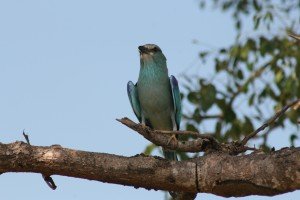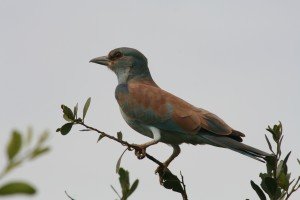Punda Maria & Pafuri 2
My favourite part of Kruger National Park is the far north – around Punda Maria and Pafuri. There is something mystical about this area, it has a very tropical feel with its diverse habitats and rich birdlife, featuring several rarities.
And so it seems entirely fitting that this area is one of two (the other being the Pilanesberg) where I have seen the mysterious Monotonous Lark, a little-known nomad that may or may not be an intra-African migrant because it only ever seems to be seen in Southern Africa in irruptions of breeding birds making their characteristic, persistent “for syrup is sweet” call. There seems to be no pattern to their movements, save for a link to above-average rainfall and even then, they’ll be present in an area in one year and totally absent the next.
It was also fitting that this mercurial bird was the last added to my list of 163 Kruger sightings on this trip.
As one heads out of Kruger Park via the Punda Gate, there is a little detour one can take to Thulamila Koppie, rising 604m above the mixed sandveld woodlands of the Punda Maria area. It’s a great vantage point to look out over the expansive plains to the east and south and it was from this spot that I watched the solar eclipse in 2002.
But the 3km drive to the top of the koppie also takes you through interesting birding habitat with the diverse vegetation featuring bushwillows, Marulas and Tree Mopanes. It’s ideal habitat for Monotonous Lark and sure enough, there they were calling away from the trees in the plain below the koppie.
The Purple Roller, a real lover of woodlands, was there as well and Crowned Hornbill was seen flying over before the turn-off to Thulamila.
The Punda Maria region is famous for its beautiful broadleafed woodlands, flourishing in an area that boasts the second-highest rainfall in the park (650mm per annum; compared to the 700-750mm in the relatively high altitudes of the rolling hills around Pretoriuskop in the south-west).
The Mahonie Loop is a fabulous drive around the hill that hosts Punda Maria camp, with a stunning diversity of trees growing in the sandveld and a concurrent multitude of birds.
Doing the loop counter-clockwise, the Dimbo stream is a profitable early spot. A pair of African Black Duck were in the shallow water, while Black Widowfinch was in the trees above.
There are plenty of Buffalo this far north and Redbilled Oxpecker was in attendance, while African Green Pigeon were enjoying the Jackal Berries. Longtailed Paradise Whydah was present on the south-western side of the loop.
Punda Maria camp is surrounded by Mopane, which is never the richest of birding habitats, so the camp provides an island of woodland habitat and is excellent for birding.
Heuglin’s Robin, resident in the thickets on old anthills, was somewhat frantically calling away and the cute Collared Sunbird were passing through as I returned from the Mahonie Loop. That night a Thicktailed Bushbaby came and visited my campsite, clambering along the trees above me at suppertime.
There is another dirt road to the east of the Mahonie Loop, the S60, which is also a beautiful route, great for birding. The S60 skirts the Gumbandebvu Hill and travels through wonderful subtropical sandveld woodland as well as mature Mopane forests, before reaching the open grasslands around Klopperfontein Drift, where many exciting sightings have been made.
White Helmetshrike is a regular on the slopes of Gumbandebvu, while the grasslands around Klopperfontein produced Western Redfooted Falcon, Dusky Lark, Amur Falcon, Martial Eagle and Browncrowned Tchagra. A Black Crake was pottering around the actual dam, where Diederik Cuckoo were also present.
Beyond Klopperfontein, the undulating tar road (H1-8) takes one towards the sandstone ridges that signal the floodplains of the Luvuvhu and Limpopo Rivers, and Pafuri, probably the most famous birding spot in Kruger Park.
Pafuri is lushly vegetated with acacia woodland grading into fever tree forests and then thickening as one enters the tropical riverine forest.
The area has changed considerably, however, since my first visit in 1998. Since then the 2000 floods and elephant damage have thinned out the taller trees and thicker bushes, and lately the Nyala Drive, heading westwards, has been more profitable than the better-known drive eastwards to Crooks’ Corner.
Redbilled Helmetshrike, Longtailed Starling – a tropical African species that is rare in South Africa but far more common around Pafuri – Redheaded Weaver, Hooded Vulture, Brubru, Woollynecked Stork and screeching Brownheaded Parrots were good sightings along Nyala Drive.
Pafuri picnic site always throws up something interesting though and on this occasion Grey Penduline Tit was with the more common Tawnyflanked Prinia in the undergrowth.
There are some interesting pans north of the Luvuvhu River bridge along the H1-9 and Marsh Sandpiper was in attendance at one of these.
Sightings list
African Black Duck
Little Swift
Common Caco
Egyptian Goose
Leopard Tortoise
Forktailed Drongo
Black Widowfinch
Goldenbreasted Bunting
Redeyed Dove
Blackeyed Bulbul
Blue Waxbill
Cape Turtle Dove
Nyala
Yellowthroated Sparrow
European Swallow
Plains Zebra
Southern Greyheaded Sparrow
Yellowfronted Canary
Redbilled Oxpecker
Rattling Cisticola
Grey Hornbill
Green Pigeon
Lilacbreasted Roller
Paradise Flycatcher
Impala
Laughing Dove
Crested Barbet
Greater Kudu
Crested Francolin
Brown Snake Eagle
Bushbuck
European Bee-Eater
Longtailed Paradise Whydah
Collared Sunbird
Grey Lourie
Redbilled Woodhoopoe
Woodland Kingfisher
Grey Duiker
Blackbacked Puffback
Vervet Monkey
Emeraldspotted Wood Dove
Heuglin’s Robin
White Helmetshrike
Southern Masked Weaver
Blacksmith Plover
Threebanded Plover
Whitewinged Widow
Spotted Flycatcher
Fantailed Cisticola
Western Redfooted Falcon
European Roller
Dusky Lark
Elephant
Yellowbilled Hornbill
Tawny Eagle
Amur Falcon
Swainson’s Francolin
Longtailed Shrike
Melba Finch
Crowned Plover
Cinnamonbreasted Rock Bunting
Bateleur
Whitebacked Vulture
Hadeda Ibis
Wattled Starling
Martial Eagle
Little Bee-Eater
Browncrowned Tchagra
Redbacked Shrike
Greater Blue-Eared Starling
Thicktailed Bushbaby
Burchell’s Coucal
Buffalo
Redbilled Buffalo Weaver
Boomslang
Redbilled Helmetshrike
Natal Francolin
Longtailed Starling
Giraffe
Whitefronted Bee-Eater
Tree Squirrel
Jacobin Cuckoo
Redheaded Weaver
Southern Black Flycatcher
Slender Mongoose
Hooded Vulture
Kurrichane Thrush
Brubru
Striped Cuckoo
Woollynecked Stork
Arrowmarked Babbler
Steelblue Widowfinch
Marabou Stork
Brownheaded Parrot
Whitebrowed Scrub Robin
Cardinal Woodpecker
Warthog
Grey Penduline Tit
Wahlberg’s Eagle
Tawnyflanked Prinia
Yellowbreasted Apalis
Marsh Sandpiper
Black Crake
Chacma Baboon
Carmine Bee-Eater
Wiretailed Swallow
Pied Kingfisher
Wood Sandpiper
Brownthroated Martin
Diederick Cuckoo
Hamerkop
Redbilled Firefinch
Nile Crocodile
Common Scimitarbill
Greenbacked Heron
African Hoopoe
Crowned Hornbill
Purple Roller
Glossy Starling
Monotonous Lark








